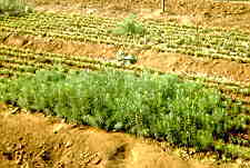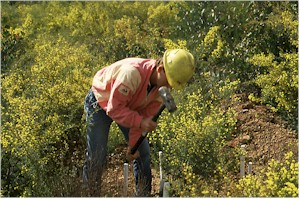Commercial applications
Given that mycorrhizas are nearly always beneficial to a plants growth, and often health, their potential use to humans, in terms of agriculture and horticulture, could be immense. Despite this potential inoculation of crops is rarely seen and mycorrhizas are only introduced deliberately in a few industries.
Many studies have shown that a variety of crops respond well to inoculation with arbuscular mycorrhizal (AM) fungi (Fig. 1). The major crop plants, maize, wheat and barley, show growth rates increasing by 2.3, 3 and 4 times respectively when inoculated with AM fungi. Onion inoculated with AM fungi show growth 6 times greater than non-AM onions.
 |
| Fig. 1. A typical crop experiment, with only the area in the foreground receiving mycorrhizal inoculation. The increased growth of plants in this area compared to the non-mycorrhizal areas is obvious. From Kendrick (1999) The Fifth Kingdom. © Mycologue Publications with permission. |
Despite the possible yield increases, the commercial use of mycorrhizas has yet to take off. In developed countries, its use may increase as the demand for organic food continues to grow. The increases in growth and pathogenic resistance could be supplied by inoculating soil with mycorrhizas rather than using fertilisers, pesticides and fungicides. Similarly, in developing countries, inoculating soil once with a suitable fungal isolate could do away with the need for repeated applications of expensive fertilisers that farmers cannot readily afford.
Forestry is one of the industries that have fully acknowledged the role of mycorrhizas in plant growth. The majority of commercial timber comes from trees forming ectomycorrhizal (ECM) associations and accounts for more than 3 billion m3 felled annually, and is valued at over $270 billion (in 2007/8). New plantations benefit considerably from ECM inoculation, especially on ground previously uncolonised by ECM trees.
Similarly, exotic trees (i.e. non-indigenous species) nearly always fail to grow in other parts of the world unless suitable fungi are introduced with them (Fig. 2 ). The palms shown in Fig. 2 are from a garden in Surrey, UK (which is well outside the palm zone) and their cultivation does require special attention. However, once one exotic has established, others of its species are easier to grow, since the mycorrhizas are already be in the soil.
 |
| Fig. 2. Exotic species, such as the palms shown here in a Surrey garden, may require mycorrhizal inoculation to survive. © Andrew Withey with permission. |
Several other small industries regularly use mycorrhizal infection. The germination of orchid seedlings will not occur without mycorrhizal inoculation and growers wishing to propagate certain species, for what is a very lucrative industry, must supply the specific isolate within the growth media.
Some orchid seedlings can be induced to germinate without mycorrhizas when supplied with the necessary nutrients in artificial culture. However, these plants tend to be more susceptible to fungal disease when mature, and often die. It is generally accepted in the industry that the key to producing healthy, mature plants is to inoculate seedlings with mycorrhizas, as occurs in the wild.
An important by-product of ECM fungi is their fruiting body, the most valued being that of Tuber species - the truffle. The best edible species, T. melanosporum occurs in very limited areas in Europe, mostly France, in association with oaks, hazel, sweet chestnut and a few other trees. Truffles are difficult to find and collect and hard to cultivate, hence they are highly valuable, and can sell for anything up to £1000 per kilogram.
A more recent development in the commercial use of mycorrhizas has been for land reclamation. As mentioned in the effects section, mycorrhizal plants can tolerate higher levels of heavy metals in soils than non-mycorrhizal plants. Large areas of waste land created by mining and other heavy industrial operations can often be polluted by metals such as aluminium, iron, nickel, lead, zinc or cadmium. These in turn may affect the pH of soil and the mobility of essential nutrients such as nitrogen, phosphorus and potassium. This discourages the recolonisation of such land by plants, which can lead to bare soil being eroded and remaining unstable.
 |
| Fig. 3. Native legume species, such as the Acacia species shown here, are important components of mine rehabilitation. Like most legumes, they form mycorrhizal associations and therefore have the capacity to benefit from the increased phosphorous uptake that this association confers. © David Jasper with permission. |
Restoration can be very costly, involving steps such as reshaping and regrading of slopes, waste removal, addition of artificial fertilisers and pH corrections. Despite these actions, up to 90% of plants may still fail to establish. A common reason for this failure to establish is the absence of mycorrhizas. Mycorrhizas can prevent heavy metal poisoning and help seeds to germinate successfully. The fungal sheath stores, and effectively immobilises, heavy metals and this acts a a natural clean-up mechanism for soils (Fig. 3).
Mycorrhizas can also initiate the cycling of nutrients, taking up immobile nutrients that would otherwise be unavailable to plants. This is particularly important since mine soils and industrial wastes are often deficient in nitrogen and phosphorus. Once a mycelial network has grown through, soil structure and stability improves and the land is well on the way to being restored.
Find out more about the nutrient exchange between mycorrhizas and their host plant, and the effects of mycorrhizas by clicking on the hyperlinked phrases.
Further information about mycorrhizas can be found in the new textbook 21st Century Guidebook to Fungi by David Moore, Geoffrey D. Robson & Anthony P.J. Trinci. Published 2011 by Cambridge University Press: ISBN: 9780521186957. URL: ttp://www.cambridge.org/gb/knowledge/isbn/item6026594/?site_locale=en_GB. View Amazon page.
Updated December 15, 2016
